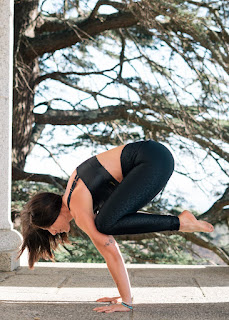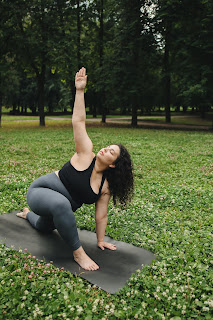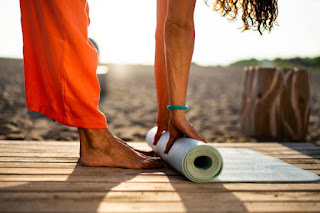Yoga for Physical Health: Beyond Flexibility
In the modern wellness landscape, yoga stands out not just as a pathway to flexibility but as a comprehensive regimen for holistic physical health. “Yoga for Physical Health: Beyond Flexibility” delves into the multifaceted benefits of yoga, extending far beyond the popular notion of it merely being a series of stretches. This practice, rooted in ancient traditions, has evolved to meet contemporary health needs, offering a solution to today’s sedentary lifestyle and stress-induced ailments.

Yoga’s benefits encompass strength building, posture improvement, enhanced cardiovascular health, and tailored approaches for special conditions, making it a versatile and inclusive practice. Whether you’re looking to build core strength, improve your posture, boost your heart health, or find healing and rejuvenation through restorative practices, yoga offers a path. By integrating specific yoga poses and sequences into your routine, you can unlock these benefits, leading to a healthier, more balanced life.
As we explore the depths of yoga’s impact on physical health, we will uncover how it goes beyond mere flexibility to touch upon strength, posture, cardiovascular health, and specialized needs. This article aims to provide a comprehensive guide to harnessing the full spectrum of yoga’s benefits for the body, making it an essential read for anyone looking to enhance their physical wellness through this time-honored practice.
Yoga for Strength Building: Core, Arms, and Legs
In the journey towards physical health, strength is a cornerstone that supports not just our daily activities but also our overall well-being. Yoga, often misperceived as solely a flexibility practice, is a powerful tool for building strength across the body’s core, arms, and legs. This section highlights how yoga can be an integral part of strength training, detailing specific poses that target these crucial areas.
Core Strength: The Foundation of Physical Health
The core is the body’s central pillar, supporting posture, balance, and overall physical health. Yoga offers an array of poses that specifically strengthen the core, including Plank Pose (Phalakasana), Boat Pose (Navasana), and Warrior III (Virabhadrasana III). These poses challenge the core muscles, including the abdominals, back muscles, and obliques, enhancing stability and power.

Building Arm Strength with Yoga
Yoga poses such as Downward-Facing Dog (Adho Mukha Svanasana), Chaturanga Dandasana, and Crow Pose (Bakasana) are excellent for building arm strength. These poses require bearing weight on the arms, which strengthens the biceps, triceps, and shoulders, contributing to a more toned and powerful upper body.
Leg Strength and Stability through Yoga
For leg strength, poses like Warrior II (Virabhadrasana II), Chair Pose (Utkatasana), and Tree Pose (Vrikshasana) are incredibly effective. These poses target the quadriceps, hamstrings, calves, and glutes, promoting muscle endurance and stability. By incorporating these asanas into your practice, you can build stronger, more resilient legs capable of supporting a wide range of activities.
Integrating yoga into your strength training regimen offers a holistic approach, enhancing not only muscle tone and endurance but also flexibility and mental resilience. The beauty of yoga lies in its adaptability; it can be modified to suit beginners and seasoned practitioners alike, making strength-building accessible to all.
Yoga’s approach to strength building is unique in that it combines physical exertion with mindful breathing and mental focus. This not only maximizes the physical benefits but also promotes a sense of inner peace and focus, integrating the mind and body in the pursuit of health and well-being.

Yoga for Improved Posture: Techniques and Benefits
In an era where many spend hours hunched over screens, posture has become a significant health concern. Poor posture can lead to a host of issues, from back pain to compromised breathing. Yoga offers a proactive approach to improving posture, leveraging both its physical and mindful aspects to cultivate a straighter spine and a more balanced stance.
The Importance of Good Posture
Good posture is crucial for more than just aesthetic reasons. It affects every physiological function, from breathing to digestion, and can significantly influence mood and energy levels. Yoga, with its emphasis on alignment and balance, teaches the body to align itself correctly, thereby improving posture.
Yoga Techniques for Better Posture
Certain yoga poses are particularly effective for enhancing posture. Mountain Pose (Tadasana) is the foundation of all standing poses and teaches the alignment of the spine, while Cobra Pose (Bhujangasana) and Cat-Cow Stretch (Marjaryasana-Bitilasana) gently strengthen the back muscles, crucial for maintaining an upright posture. Additionally, Tree Pose (Vrikshasana) and Warrior I (Virabhadrasana I) are excellent for building the core and leg strength necessary for good posture.
Benefits Beyond the Physical
The benefits of improved posture extend beyond physical health, impacting mental well-being and confidence. A straight, aligned posture can enhance breathing, increase concentration, and project confidence, thereby positively influencing our interactions and day-to-day activities.
Yoga’s mindful approach to movement and breathing encourages practitioners to be aware of their posture throughout the day, not just on the mat. This awareness leads to gradual, sustainable improvements in posture, contributing to overall health and well-being.
Incorporating Posture-Improving Yoga into Daily Life
To reap the posture benefits of yoga, consistency is key. Incorporating a few minutes of posture-focused yoga into your daily routine can lead to significant improvements over time. Practicing these poses regularly trains the body to maintain proper alignment, reducing the risk of posture-related problems.

Yoga for Cardiovascular Health: Heart-Friendly Practices
Cardiovascular health is a critical component of overall wellness, influencing everything from energy levels to longevity. While aerobic exercises are commonly touted for heart health, yoga’s unique blend of physical activity, breathing exercises, and stress reduction plays a pivotal role in supporting a healthy heart.
Yoga’s Impact on Heart Health
Yoga’s heart benefits stem from its ability to lower stress, reduce blood pressure, and improve circulation. Practices like deep breathing and meditation, integral to yoga, activate the parasympathetic nervous system, reducing stress levels and thereby positively affecting heart health. Poses that promote relaxation, such as Legs-Up-the-Wall (Viparita Karani) or Gentle Seated Forward Bend (Paschimottanasana), can help lower blood pressure, a key factor in cardiovascular health.
Dynamic Yoga for Cardiovascular Strength
While all yoga promotes heart health to some extent, certain dynamic styles, such as Vinyasa or Ashtanga, can be particularly beneficial for strengthening the cardiovascular system. These practices involve a continuous flow of movement linked with breath, providing a moderate cardiovascular workout that can improve heart rate variability, an indicator of heart health and resilience.
The Role of Stress Reduction
Stress is a significant risk factor for cardiovascular disease. Yoga’s holistic approach addresses stress through mindfulness meditation and pranayama (breath control), which have been shown to improve mental well-being and, by extension, heart health. Regular yoga practice can help manage stress levels, reducing the risk of stress-related heart issues.
Tailoring Yoga for Heart Health
For those specifically looking to improve cardiovascular health through yoga, incorporating a mix of dynamic practices for aerobic benefit and restorative yoga for stress reduction can offer a balanced approach. Additionally, consulting with a healthcare provider or a yoga therapist can help tailor a practice to individual health needs and conditions.
Scientific Support for Yoga’s Cardiovascular Benefits
Emerging research supports yoga’s benefits for heart health, showing potential in managing hypertension, improving lipid profiles, and enhancing overall cardiovascular fitness. These studies reinforce yoga’s role as part of a comprehensive approach to cardiovascular wellness.

Yoga for Special Conditions: Modifications and Precautions
Yoga’s versatility makes it accessible to virtually everyone, including those with special health conditions. Whether dealing with chronic pain, injury, or illness, yoga offers modifications and precautions to ensure a safe and beneficial practice. This section explores how yoga can be adapted to cater to specific needs, enhancing well-being without risk.
Understanding the Need for Modifications
The principle of “ahimsa” or non-harming, central to yoga philosophy, underlines the importance of avoiding injury and discomfort during practice. For individuals with special conditions, such as arthritis, back pain, or heart disease, standard yoga poses may require modifications to prevent strain and maximize benefits. Props like blocks, straps, and cushions can assist in these modifications, making poses more accessible.
Consulting with Healthcare Providers
Before embarking on a yoga practice tailored to special conditions, it’s crucial to consult with healthcare professionals. They can offer guidance on which types of yoga might be most beneficial and which poses to avoid. This collaborative approach ensures that yoga complements medical treatment plans without compromising health.
Specialized Yoga Practices
For those with specific conditions, certain yoga styles and practices may be more appropriate. For example, Iyengar yoga, known for its use of props and focus on alignment, can be particularly suitable for individuals needing support to achieve poses. Similarly, gentle yoga styles, such as Yin or Restorative yoga, are ideal for those looking for a more meditative, less physically demanding practice.
The Role of a Qualified Yoga Instructor
Working with a yoga instructor trained in therapeutic yoga or familiar with modifications for special conditions can be invaluable. These instructors can create personalized yoga sequences that address individual health challenges, ensuring a safe and effective practice.
The Benefits of Yoga for Special Conditions
Despite the need for precautions, yoga’s benefits for individuals with special conditions are profound. Beyond physical health, yoga offers emotional and mental support, reducing anxiety and improving quality of life. With the right modifications and guidance, yoga can be a powerful tool for healing and well-being.
Restorative Yoga: Healing and Rejuvenation
Restorative yoga stands as a sanctuary for healing and rejuvenation within the yoga practice spectrum. Characterized by its gentle, supportive postures and emphasis on relaxation, this form of yoga serves as a counterbalance to the stresses of modern life and the physical exertion of more dynamic yoga styles. This section explores the essence of restorative yoga and its vital role in promoting physical and mental health.
The Essence of Restorative Yoga
Restorative yoga involves poses that are held for longer periods, often supported by props such as blankets, bolsters, and blocks. This support allows the body to fully relax and release, facilitating deep rest. The practice focuses on calming the nervous system, which can help reduce stress levels and promote healing from within.
Benefits for Physical Health
The gentle nature of restorative yoga makes it particularly beneficial for those recovering from injuries or dealing with chronic pain. By encouraging relaxation and improving circulation, it aids in muscle recovery and flexibility. Additionally, the deep relaxation state induced by restorative yoga can help lower blood pressure and improve sleep quality, both crucial for physical health.
Mental and Emotional Healing
Restorative yoga is not only beneficial for the body but also for the mind and spirit. The practice offers a space for mindful reflection and meditation, allowing practitioners to release emotional tension and achieve a state of inner peace. This mental and emotional clearing can lead to reduced anxiety, improved mood, and a greater sense of well-being.
Integrating Restorative Yoga into Your Practice
Incorporating restorative yoga into a regular yoga practice or as a standalone routine can provide a powerful antidote to stress and fatigue. Even just a few minutes of restorative yoga can reset the mind and body, making it a valuable tool for anyone seeking to enhance their health and relaxation.
The Role of Breath in Restorative Yoga
Breathwork, or pranayama, is a key component of restorative yoga, enhancing its relaxing and healing effects. Techniques such as deep abdominal breathing or the three-part breath can help deepen the sense of relaxation and promote a meditative state, further augmenting the practice’s benefits.
Restorative yoga embodies the healing and rejuvenating spirit of yoga, offering a peaceful retreat for the body and mind. It underscores the holistic approach to wellness that yoga represents, catering not just to physical health but also to mental and emotional balance.

“Yoga for Physical Health: Beyond Flexibility” has journeyed through the comprehensive benefits of yoga, from building strength and improving posture to enhancing cardiovascular health, adapting for special conditions, and offering restorative practices for healing and rejuvenation. This holistic approach to physical health underscores yoga’s versatility and its profound impact on well-being. By embracing yoga’s full spectrum, individuals can enjoy a more balanced, healthy, and fulfilling lifestyle, illustrating that yoga truly offers something for everyone, beyond just flexibility.





